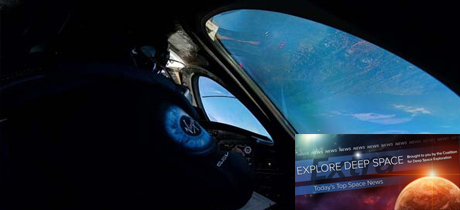In Today’s Deep Space Extra… The first two astronauts on the Moon in more than 50 years will spend about six to seven days on the lunar surface during the Artemis 3 mission. NASA makes new strides in its partnership with commercial space companies for suborbital and orbital pursuits as the agency turns its human exploration focus to deep space.
Human Space Exploration
Don’t expect NASA’s 1st Artemis astronauts to drive on the Moon in a fancy lunar car
Space.com (6/23): A recent NASA presentation about the early Artemis missions intended to return human explorers to the surface of the Moon in 2024 suggest Artemis 3, the first landing with two astronauts, will include a six to seven day stay and opportunities for about up to six hour spacewalks, perhaps covering up to ten miles. Efforts to provide a surface rover to extend astronaut exploration activities will likely await a second mission with astronauts.
Commercial human spaceflight making strides
Coalition Members in the News – Axiom, Boeing
Spacepolicyonline.com (6/23): NASA announced plans Tuesday to make use of commercial suborbital launch services like those in the offing by Blue Origin and Virgin Galactic for the launch of astronauts and other agency personnel for training and science and technology development purposes. The move follows a recent announcement in which NASA and Virgin Galactic entered a Space Act Agreement in which the company will solicit and prepare private astronauts for missions to the International Space Station (ISS).
NASA to pay to fly employees on New Shepard, SpaceShipTwo
Coalition Member in the News – Boeing
Parabolicarc.com (6/23): NASA announced Tuesday it has established an office within its Commercial Crew Program for launching astronauts and other agency personnel on commercial suborbital launch vehicles. Virgin Galactic’s SpaceShipTwo and Blue Origin’s New Shepard appear to be among the potential early providers for research and training missions.
Space Science
Foam ‘spider webs’ from tiny satellites could help clean up space junk
Space.com (6/23): Russian startup StartRocket proposes a strategy for removing orbital space debris, a mounting concern for future commercial space activities in low Earth orbit. StartRocket’s small satellite “Roomba” is to feature a “foam debris catcher” capable of snagging space junk with a sticky polymer foam and would then descend destructively into the Earth’s atmosphere.
Baby planets are born exceptionally fast, study suggests
Science (6/16): Scientists using the Atacama Large Millimeter/submillimeter Array in Chile have discovered evidence that the planet forming process from dust and gas around newborn stars may unfold much more rapidly than theorized previously. By studying stars a mere one to three million years old they’ve found evidence of extrasolar planet formation within a half million years. Findings were published in the journal Astronomy & Astrophysics.
Other News
Pentagon Chief Technology Officer, Deputy to resign on July 10
Reuters via New York Times (6/23): Mike Griffin, the former NASA administrator, has announced his departure from the Pentagon, where he has served as Undersecretary of Defense for Research and Engineering since 2018, to join the private sector. His deputy, Lisa Porter, is departing as well. The departures are effective July 10.
Another Starship test ends in an explosion
Universe Today (6/23): For a seventh time at its South Texas production facility, SpaceX has pressurized a prototype propellant tank for its reusable Starship launch vehicle and for the second time intentionally pressurized the structure until it failed. The activities involved a new type of stainless steel structure and a change in manufacturing technique under evaluation.

